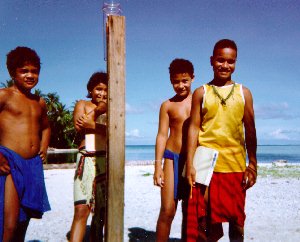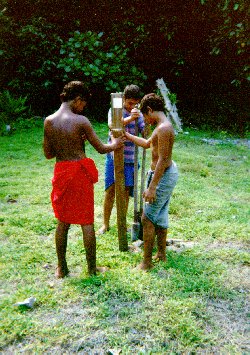
The Schools
of the Pacific Rainfall Climate Experiment (SPaRCE)
is a cooperative
field project involving local meteorological services,
elementary,
middle school, high school, college, and trade school
students
from various Pacific islands, atolls, and the U.S. The
SPaRCE
program (headquartered at the University of Oklahoma in
Norman,
Oklahoma) began in January 1993 with only a handful of
Pacific
schools. Since its implementation, the project has quickly
grown.
There are currently over 160 schools from approximately
22 different
countries enrolled.

Students
from Eaurpik School in Yap taking a rainfall reading from
their
rain gauge.
Initially,
participants are sent two direct-read, plastic rain gauges
along with
an instructional video tape and manual for placing,
reading,
and maintaining the rain gauges. A single-use camera is
also sent
out to make photographic documentation of the rain
gauge locations.
Most of the SPaRCE sites are on small islands
and atolls
which have very little funding for computers or special
projects.
SPaRCE provides environmental education and
enhancement
of Pacific island science programs. In addition to
the first
workbook and video, five additional workbooks and videos
addressing
topics such as global climate, general weather, and
Pacific
regional climate are sent to participants. As participants
progress
in the program, they receive additional instrumentation,
such as
sling psychrometers and max-min thermometers, and
other educational
materials, such as science posters and science
experiment
kits.
Goals of the SPaRCE Program
